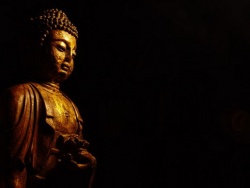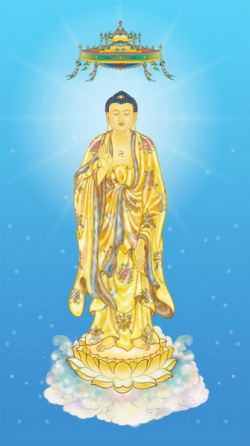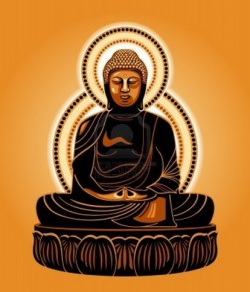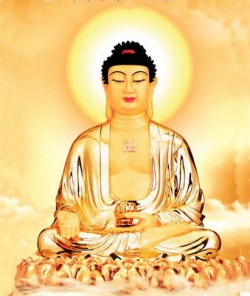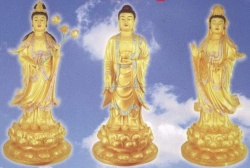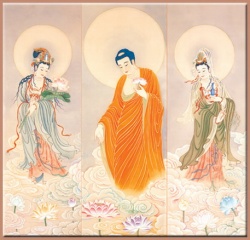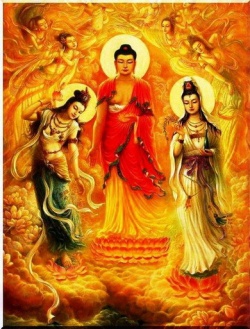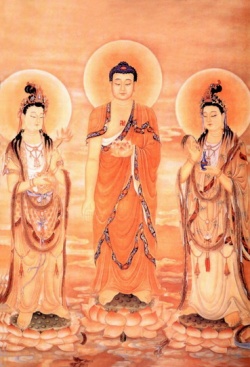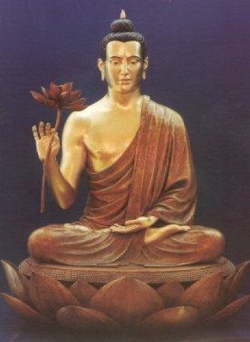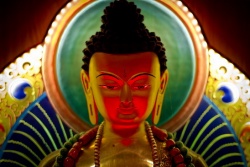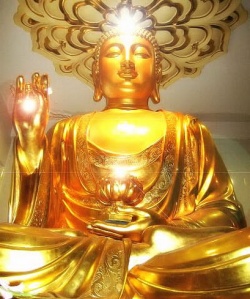Monastic Buddhism in the Medieval Period and the 84 Mahasiddhas
The Medieval Period and Rise of Scholasticism
About a century before the dawn of the Christian era, nomad tribes from interior Asia, known as Shakas or Scythians, led by the powerful warlord Moga, invaded and conquered the north-west corner of India. One of these Shakas named Azes appears to have inaugurated the Vikrama Era in 58 BC. After him came Azilises, and then around 5 AD, King Azes II.
Not long after 19 AD the power of the warrior Shakas was broken by the Parthians under Gondophares.1 And then another Asian tribe who called themselves the Kushans, were driven westward into the lands of the Shakas and Parthians by the Chinese. Upheaval followed upheaval. Around 78 AD2 the Kushan king Kanishka finally consolidated much of Afghanistan and much of the northern region of India, including Kashmir, under his dominion. He established what might be called a "pax Kushana", in part by subduing local regions under feudal rule. Kanishka adopted and promoted Buddhism throughout his empire.
In brief, we may state that the period from the Buddha up to the era of Kanishka, a period of 630 years, covers the most important phase of initial development in Buddhism. During this period the foundations of Buddhist teaching and practice were laid down: the formation of the Eighteen Orders, the fixing of the Vinaya in its present editions, and the setting down of the metaphysical doctrine (Abhidharma) in written form.
Between the time of Kanishka up until the dawn of what we are calling the Medieval Period three great intellectual movements appear to take place in Buddhism.
First of all, there was the southern saint whose impact on Buddhist thought would be enormous: Arya-Nagarjuna, author of the profound philosophical treatise, Mulamadhyamaka-karika. This Nagarjuna was a contemporary of the first century emperor Satavahana, who ruled over a large portion of southern India.
The next event of great importance was the gradual emergence into the light of day of what are known as the Mahayana-sutras (or vaipulya-sutra). The Tibetan historian Taranatha tells us that the first to hear of these sutras was the second century King Laksasva. He built several monasteries and temples on Mount Abu, a mountain largely settled by Parsee followers of Zarathustra from Iran—a mountain which today stands in Rajastan close to the border of Gujarat. Mount Abu supports a 1200 metre high plateau with a beautiful sacred lake in its centre. King Laksavara invited teachers and monks of the Mahayana tradition to reside in the monasteries that he established there.
Taranatha records that after the establishment of a centre on Mount Abu, there appeared many teachers of the Mahayana who received inspiration from celestial Bodhisattvas, such as Manjusri, Avalokitesvara, Guhyapati, Maitreya and Vajrapani. Once that the Mahayana sutras had been brought into the world, their dispersal was rapid. In 67 AD Kasyapa Matanga and Dharmaraksa set forth from Gandhara (northwest India) on the silk route to China, carrying with them on the back of a white horse a gold statue of the Buddha and the Mahayana sutra of 42 sections. Somewhere in the wastes of Tokharistan they met agents of the Chinese Emperor Mingti, who claimed that the Emperor had had a dream of a golden man, radiant as the sun, travelling on a white horse toward China. Kasyapa and Dharmaraksa were consequently escorted to the Han capital, Loyang. There they were introduced to the Emperor himself, to whom they explained the Mahayana way of compassion and wisdom, and the White Horse Temple (Ch. Pai-ma-ssu) was erected in Loyang for their use. Thus, carried like seeds, the Mahayana quickly flowered in the Dharma-garden of the east.
The third great spiritual movement to arise in the Buddhist world was the Yogacara, inaugurated by Asanga and Vasubandhu (290-370 AD), as a corrective against the rise of scholasticism that was then replacing the contemplative tradition in India.
Davidson categorizes the birth of the Medieval Period in Indian history with the final demise of the Imperial Guptas around 550 AD and the death of King Harsha in 647. This period in history, approximately from c. 500 AD to 1200 AD, he describes as
"messy and confusing… It is the period of rise of cultural forms that British and continental authors loved to hate and that some Indians acknowledge with chagrin: tantrism, bhakti, excessively sophisticated poetry, sati, the solidification of the caste system, and the rapacious appropriation of tribal lands, to mention a few."3
It was also a period marked by the decline of women's rights, the advent of kamasutra and pornography in Indian culture, and in Buddhism, an eclipse of the earlier meditative tradition. In many cases we find that women's Orders of nuns disappear during this time, as their right to have independent lives are gradually curtailed. With the decline of meditation, scholasticism becomes the main Buddhist activity to take its place.
The great University of Nalanda was founded by King Kumaragupta who reigned c. 415-455 AD. When Fa-Hien visited Nalanda in the fourth century it was a rather desolate little place called Nala, chiefly remembered for being the village where Shariputra was born and where his remains were laid to rest in a Stupa. But after its inauguration by Kumaragupta, building continued through the next five successive reigns, to be finally completed by King Yasodharma in 535 AD. Nalanda became the leading light for scholastic Buddhism. By the time that Rahulabhadra, ordained in the Mula-sarvastivada Order (see Early Buddhist Monastic Tradition & Today), became an abbot at Nalanda, the place had grown into a full scale University, with a large faculty. Rahulabhadra, the teacher of Nagarjuna II (author of the Mahaprajnaparamita-sastra, a commentary on the Prajnaparamita-sutra in 25,000 slokas), was a contemporary of the Madhyamaka scholars Kamalagarbha and Ghanasala.
The Chinese monk I-ching has left us with a detailed report of life at Nalanda around 671 AD, at the time of his trip to India. According to his report, Nan-hai chi-kuei nei-fa chuan, Nalanda was a giant University supporting many thousands of students and scholars at state expense.
I-ching mentions the different Buddhist monastic Orders existing in his time: the Mahasanghika, Theravada, Mula-Sarvastivada and so forth. He says that some members of these Orders practiced a Hinayana form of Buddhism; others adhered to the Mahayana. There were evidently, for example, Mahayana practitioners who were monks of the Theravada Order, or conversely, Sarvastivada who kept strictly to the Hinayana. In contrast, nowadays it is generally said that the Theravada entirely eschews the Mahayana, but in earlier times this was evidently not the case.
A concise description of these two Ways (ayana) of Buddhism, which thrived during the medieval period, has been given by Prof. Conze, who said as follows:
"The adherents of the Mahayana and Hinayana both practice the same Vinaya, recognize the same five categories of faults, are attached to the same four Truths. Those who worship the Bodhisattvas and who read the Mahayana-sutras get the name of Mahayanists; those who do not are Hinayanists."4
During the Medieval Period monastic life became far more regulated. Just as feudalism, first introduced by the foreign Kushans some centuries earlier, replaced earlier democratic systems in Indian politics, so too it made formidable inroads into religion. "Scholasticism" is a word used to describe the style of learning and education dominant prior to the rise of humanism in Europe; however, it is also a term eminently suitable to describe the early medieval period in Indian Buddhism. Scholasticism (from the Latin schola, or school) implies an exhaustive and detailed study of a given set of "authorized" texts embodying the transmitted knowledge of a particular school of thought. In support of the philosophical position of the school to which a particular student might belong, the student would first undertake a long, painstaking, closely supervised reading of the approved authorities. He would then be trained to engage in the art of disputatio, i.e., the standard forms of debate that adhered to an established logic system, to prove the overall veracity of the text that he was trained in. Graduates became expert upholders of the view maintained by their respective schools. Loyalty to a given school of thought was not so much based on a personal search for understanding and Truth; rather, it was a feudal obligation to one's school or lineage.
Students of a particular school were often connected to their given school through clan and family ties. This principle often had economic foundations. Royal patronage of a monastery meant that the intellectual and professional abilities of members of the monastic establishment were at the service of the king.
The traditional support of monastics by local donation changed during the medieval age into a system of feudal taxation. Large monasteries and universities became the owners (by royal decree) of villages and districts, from which they could draw support at demand. One benefit of this system was that the great monastic universities, such as Nalanda, Vikramasila, Odantapuri, and so forth, might be attended without cost to either the students or faculty, i.e., the universities and monasteries were maintained at state expense. But the downside was the fact that the burden of this expense rested on the backs of the people, the villagers themselves, who had no say in the matter. Another evil was the dependency of the monasteries to the royal whim.
Conceptual changes also arose. While in earlier Buddhism the ideal was embodied in the Arhat, the saint, the ascetic, the enlightened one (bodhisattva), or in other words the man or woman who attained realization through spiritual practice and meditation, during the Medieval Period the ideal person became the savant, the most brilliant scholar. The clerics and the favoured monastic priests (purohit) that served the royal court, were intellectuals recognized for the infinite amount of literary knowledge they had succeeded in memorizing. The greatest scholars (pandits) were they who could demonstrate their erudition in public contests of debate.
Through disputation against every foe, the scholar was expected to uphold the position of his (and it was usually a "he" since womens' position sank to an all-time low) own school. The scholar who conceded a major public debate was more than often made to join the winning school. Since this could result in far more than loss of face—indeed, more than likely in a loss of one's social position and university professorship, and therefore a loss of salary—failure could pose a major disaster. The promotion of scholarly learning and memorization of minuscule detail was therefore pushed to extreme limits.
In the Pancaka Nipata of the Anguttaranikaya there is a prediction by the Buddha regarding the decline of the Buddhist contemplative life:
"In the future, Bhikshus will put forth no effort to attain the unattained, to master the un-mastered, to realize the unrealized, since those who come after, falling into wrong views, will become indulgent, lazy and degenerate. Thus, Bhikshus, from corrupt Dharma comes corrupt discipline, from corrupt discipline comes corrupt Dharma."
Reform Movements: Tantric yogis and Forest monks
The ideal of the Enlightened one did not disappear, even though the culture-hero of the age was epitomized by the great Pandit.
Whenever the meditation tradition dies out amongst a Buddhist population, certain individuals eventually come forth to revive it. This has happened over and over in Buddhism.
However, a return to meditation was not always possible within monasteries were the contemplative tradition was superceded by rigid adherence to rules and ritual. Quite apart from encouraging scholastic pursuits, monasteries in the Medieval Period focused on keeping the vows and the routine of living a pure life as a monk, with the consequence that actual meditation practice was put on the back burner. Since this resulted in no one attaining interior spiritual experience, the word went out that saints (aryas) were a phenomena of the past.
As the Medieval Period deepened, monastic life continued to become more and more stagnant.
Around 700 AD numbers of monks started "dropping out" of the monasteries, and to a very large degree, dropping out of society altogether. Often adopting low-caste employment as a means of support, these monastically trained and often very learned "drop outs", took to the life of Yogis and Yoginis in pursuit of inner wisdom. These mystics were frequently referred to as siddhas or adepts, practitioners of Tantric Buddhism, and they were noted for performing saintly miracles.
Besides the meditation manuals expounding Yogacara doctrine, the secret lore of the siddhas was encapsulated in a number of unique mystical scriptures known as the Tantras. The story goes that the first of these secret treatises to appear in the world were brought to this planet by non-terrestrial beings.
The historical transmission is very briefly related as follows: The esoteric teachings, the Secret Tantra, originally came from the primordial Buddha-Mind itself and reached the human world in three successive levels of transmission or stages, each a step-down from the former. These are known as the mind-transmission of the Buddhas, the symbolic transmission of the extra-terrestrial Vidyadharas, and the oral transmission of the (human) sages.
The intermediary in this transmission of information occurred in the communication of wisdom through non-verbal symbol-bits (Tib: brDa), passed—so it was said—from celestial Insight-holders (vidyadhara) to Bodhisattva-masters on the physical plane, whose minds had become fully ripened to receive the truth. The Insight-holders indicate the knowledge through symbol, whereat the ascended masters comprehend the perfect meaning and translate it into conceptual thought. It was the latter who then expressed it in human language.
It is said that the Tantra was brought to this world through two channels of symbolic transmission: first, transmission to a further level of extra-terrestrial insight-holders, and secondly, transmission through extra-terrestrial insight-holders to certain terrestrial (human) insight-holders.
In the old Tibetan text, the sPyi-mDo dGongs-'Dus, it is said:
"On the summit of Mount Dragshul Chan,
to the Bodhisattva friend in human form,
the sacred essence of the Knowledge,
as revealed under the directive of the Vajra-holder,
was transmitted from the solar-systems (cakravala)
of the Shining-ones."
The Bodhisattva friend mentioned in this account was a great master of our world named Vimalakirti, who is said to have received what are called the "sixty-four fundamental tantras" from four extra-terrestrial beings, the deva Dragden Chogkyong, the naga Jogpa, the yaksha Karda Dong, and the raksha Lodro Thubten. (It is interesting to speculate from the fact that the word tantra means "thread", that what is being said here is that Vimalakirti, the human sage, received from four non-human beings an awakening of the 64 threads of selectively encoded data that lie locked in the human gene bank. There are exactly 64 DNA codons in the genetic repository of the human body, just as there are 64 squares in the game of chess, sixty-four symbol-bits that, when triggered, release the full compliment of human knowledge into consciousness. The four beings are in one sense earlier archetypes for the four lineage streams that the Mahasiddha Tilopa incorporated into his oral transmission, now known as the Kagyu.) This legendary transmission is said to mark the historical origin of the Tantric tradition—the origin of the "golden rosary of knowledge" that, when later translated into human thought and written down, was intended to reveal the way whereby men and women can awaken their full potential as evolving creatures on this planet, in what (in the ancient Buddhist scriptures) is called our Saha solar-system, or Saha-cakravala.
The written tantra-texts as we possess them are frequently incomplete, and it is said that they are but the fragmentary redactions of earlier root texts (mula-tantra) now lost. These transmitted redactions are the sacred treatises that taught the science of the first Buddhist (and Hindu) siddhas and great yogins of the past.
There is a well-known group of siddhas, both male and female, who because of the lengthy commentaries on the tantras, the practical meditation manuals, the spiritual poetry, and the other religious writings that they authored, are remembered in history as the 84 Mahasiddhas, the eighty-four Great Adepts. While some of these adepts retained their monastic vows, we find that many did not. This was because of the fact, explained above, that during the late medieval period monastic life had actually become contrary to the path of Enlightenment. The eighty-four Great Adepts were the founders of various lineages of spiritual practice.
An example of the Mahasiddha may well be demonstrated by the life of the Nepalese siddha Maitripa.5 Born near Kapilavastu, in southern Nepal, Maitripa received a thorough Brahmin education up to the age of eighteen. He then joined Vikramasila monastery and came under the influence of the Mahapandita ("great scholar") Naropa, from whom he studied the logic systems of Dignaga and Dharmakirti, the Madhyamaka philosophy of Nagarjuna, and then, for two years, the epistemological hermeneutics of the Prajnaparamita-sutras. He then met Ratnakarasanti, from whom he began to gain an understanding of Yogacara mental-theory. Finally, at the age of 21, he received the Bhikshu-ordination according to the Sammitiya Order and was given the name Bhikshu Maitrigupta. He was unmatched in his erudition.
Naropa was one of the greatest scholars in India at the time. However, one day while he was resting beneath the outspread branches of a tree, reading a particularly profound philosophical text, an old lady who was a yogini came up to him. She asked him if he could understand the words of the text that he was reading and he said yes, he could. At this she showed great happiness. But when he also answered in the affirmative to the question as to whether he understood the meaning of the text, she showed great distress. In this way she shocked Naropa into the realization that all his vaunted knowledge was simply intellectual; he did not have an experiential, mystical comprehension of the Buddha's path. He was like someone who knew everything about the makeup, molecular structure and dietary aspects of ice-cream, but had never actually tasted ice-cream, and therefore had no actual experience of what ice-cream really was. In this sense, his knowledge of Dharma, was purely speculative and intellectual. He had no actual experience of the Enlightened state. He merely possessed book-knowledge.
"Who does know the meaning?" he asked. The old yogini told Naropa to seek out her brother, the homeless yogi Tilopa. This resulted in Naropa abandoning his life of scholarship altogether, in search of experiential Truth. Naropa became a disciple of the Mahasiddha Tilopa.
Naropa's discipleship under Tilopa would have occurred sometime after the period when Maitrigupta was studying at Vikramasila, since during that period Naropa was obviously still very much a professor at that University. Perhaps it was Naropa's example of leaving the university and monastic life that influenced Maitrigupta.
At any rate, in his 28th year Maitrigupta underwent a distinct revulsion for scholastic learning, very similar to that ascribed to Naropa. The historian Pema Karpo reports that a young girl of sixteen years and great beauty appeared to Maitrigupta. "Do not stay here," she reportedly said. "In the East, in the temple of Khasarpana, there is Avalokitesvara. Go and receive teaching from him." She then disappeared.6
Maitrigupta travelled in stages to Khasarpana. There he remained for one year, praying assiduously, but nevertheless not finding the master that he sought. Again in a dream he received a message, this time by a white male figure, who told him to travel to south India, to Sri Parvata, a site famous as a place of worship to Avalokitesvara.
The journey to Sri Parvata was not an easy one, however while there, he learned about the Mahasiddha Savari. Matrigupta travelled from place to place, trying to locate the Savari. For a while he settled at Vaktapad where he recited Tara's mantra a hundred thousand times. After that he became convinced that he should pursue his search in the Manda Range of the eastern Vindhya Hills. This involved a fifteen day trek to the Vikrama Peak. On the twelfth day he reached the limits of his endurance and collapsed. Despondent over his failure, and now at the age of 30, he felt like committing suicide. Just at that critical moment, the Guru Savari appeared.7
Savari means one who belongs to the Sabara tribe, an untouchable people even lower than the Dombis and Candalas, who lived by hunting wild game in the Vindhya forest. Savaripa was a famous yogi of that tribe, a disciple of Saraha, who lived with two women consorts. When Maitrigupta first came across the Guru, he found him sitting on the ground, while his two consorts were picking lice from his hair. Maitrigupta, still an orthodox Bhikshu and from a high Brahmin caste, was momentarily shaken in his faith by this scene.
Maitrigupta's first thought was to return to his monastery. Then he considered, "If I go back now, I would lose face in front of all the monks and scholars there. Maybe I should have killed myself after all." Savari, seeing the perplexity on Matrigupta's face, asked him what was wrong.
"I have deserted my life of scholarship, forgotten all the doctrines, and now, finding nothing, contemplate suicide," Maitri-gupta answered.
Savari, using the Madhyamaka-philosophical language that Maitrigupta knew so well, then said, "Tell me: Where does one find this 'forgetting of all doctrines,' when in the first place all is non-originated? Where does one find this 'forgetting all doctrines,' when in the first place all is non-ceasing? If the entire threefold Universe has always been'"liberated from the beginning,' as your philosophy says, then right now your innate Buddha-nature must be present, however much it might seem obscured by ignorance."
At these words, sudden realization dawned on Maitrigupta. The actions and appearance of the Guru he then saw as a sign pointing out the Unoriginated Nature of all things. He therefore gained unequivocal faith in Savari, whom he recognized as a real embodiment of the compassionate Bodhisattva Avalokitesvara in person.
After that Maitrigupta received secret Tantric Empowerment from Savari, and was given the name Advayapada, the one who abides (pada) beyond duality (dvaya). He then went and meditated in the forest as a yogi for twelve years.
Although his proper tantric name was Advayapada, he is perhaps better known in Kagyu history as Maitripa, one of the teachers of the Tibetan sage Marpa of Lhodrak.
It is said that by virtue of instruction, meditation and subsequent advice, there gradually developed in Advayapada an intuitive comprehension of Reality just as it is. He received a full experiential understanding of the knowledge of all the 64 tantras. Thus he became a human Vidyadhara.
Having completed the path and come to know the intrinsic nature of mind, Advayapada's initial impulse was to continue to live in the forest for the rest of his life. Mahasiddha Savari, however, pointed his finger at his disciple and admonished him, "What do you expect to accomplish without helping others? You have a fine intellect and education, therefore go and teach people the reality of the way that things are." In this manner Savari disposed of his pupil's illusions and sent him forth to pursue a career of writing and teaching.
The Mahasiddha Advayapada (Maitripa) returned to Bihar, middle India, were he proceeded to instruct large numbers of disciples. He is said to have composed some famous philosophic works at Sri Parvata and elsewhere. He became a leading exponent of Mahamudra, and under the name Maitripa is the author of a fundamental Mahamudra-treatise of the Kagyu school. (See Master Maitripa's Concise Summary of Mahamudra.)
Maitripa was somewhat younger than the great Naropa, and began to earn considerable fame just as the latter came to the end of his life. In the eastern portion of India he founded a hermitage near the Mountain of Fire Cremation Ground, and he dwelt there, teaching disciples and writing treatises on yoga. He acquired four leading disciples, seven middling disciples, and ten minor disciples. The four leading disciples were named Sahajavajra, Rama, Sunyatasamadhi, and Vajrapani.
When his time came to die, he said to the latter, "Vajrapani, go and gather all the disciples." It is said that he then made extensive Offerings and gave his last Meditation Instructions. He passed away at the age of 75.
One characteristic of the historical Eighty-four Mahasiddhas is that they are equally recognized by Buddhists and by Hindus. Apparently they were so universal in thought and practice, that they became recognized saints in both religious traditions.
The Vidyadhara in India, Burma and Tibet
The aim of the siddha in Buddhism was to attain the state of a Vidyadhara. This term needs some explanation. Vidyadhara (Tibet: Rig-dzin), literally translated, means "Insight-holder" or "Knowledge-holder". But the term has a wealth of meaning in tantric lore. A Vidyadhara is one who possesses the "knowledge of reality" whereby he or she acquires power over the physical world—he (she) stands in a privileged position vis-à-vis the Universe and can pass at will through the dimensions. Through specialized higher knowledge the Vidyadhara is able to manipulate the framework of nature.
In other words, the Vidyadhara is a master not only in terms of seeing into the mind, but wields control over the concrete field of existence – he or she can transit through space and time, and has an influence on human destiny.
In Burma, the existence of the Vidyadhara has not been forgotten. Indeed, the Shwedagon Pagoda is, to quote one author, "generally believed to be a favourite haunt of Weizzers, hermits endowed with magical powers and semi-divine beings who have come to do obeisance to it in order to gain eternal merit for their well-being in future lives."8 Here the term "Weizzer" (variously spelt, Waizzar, Weisar, etc.), is short for "Weizzer-Dho". This is the Burmese equivalent of the Sanskrit Vidyadhara.
Interestingly enough, this term also has a well-known English equivalent: Wizard. Modern Western man no longer believes in his Wizards, and treats them as fairy tales out of the past. Nevertheless, in old celtic lore, a "Wizard" was a wise man, a holder of wisdom, who could look into the past and future. Merlin, the advisor of the legendary king Arthur, was such a wizard.
A Wizard or Weizzer is a person possessed of the special knowledge whereby the fundamental ground of space and time can be subtly influenced by a mind to conform to certain desired results.
The Burmese master Bodaw Aung Min Gaung was a Weizzer, and his disciple U Tila Wunta is one at the present time.
The Burmese say that among Weizzars there are two kinds: Lawki Weizzars and Lawkuttara Weizzars. The former are Wizards who have acquired mastery over the physical world; they know the secret mantras, pentacles and talismans, by which world-events can be affected. A Sei Weizzar is a type of Lawki-wizard who uses his psychic powers for healing the sick. In Burma someone who has accomplished the transmutation of matter through alchemical science is also a Weizzar of the Lawki type. When Namgyal Rinpoche resided in Burma as a young monk he spent considerable time observing and studying with the Weizzar-alchemists who, in the old days, would often visit U Tila Wunta's monastery in Rangoon. Weizzars are also believed to be able to know who a person was in their previous lifetimes, and are able to observe the reincarnation of someone who has died. Lawki wizards are siddhas who can consciously and wilfully work miracles, as and when they choose.
Thai Buddhist TempleLawkuttara Weizzars, on the other hand, are more than ordinary this-worldly wizards; they are enlightened wizards, or in other words, wisdom-masters who have seen the foundations of Reality. They are saints who have realized the transcendental. The true Vidyadhara is a lawkuttara insight-holder.
This leads us to the Forest Monks of Burma. Forest Monks are often closely related to the Vidyadhara tradition, since they too have left the city and village monasteries to go out into the wilderness. Dissatisfied with the absence of a meditation practice amongst their fellows, the Forest Monk Tradition came into being as a reform movement. Like the Mahasiddhas of former times in India, the Forest tradition has now grown very strong wherever it manages to thrive in Burma, Thailand and Ceylon, supported by monks and nuns who want to live a spiritual life of meditation.
Milarepa and the Yogins of Tibet
Then there is the Tibetan yogin (male or female), particularly characterized by the most famous yogi of all, Milarepa.
Milarepa never became a monk. His inspiration came directly out of the Buddhist tradition of the 84 Mahasiddhas of India. He was a young man who, to revenge harm done to his mother, at first turned to sorcery. It is said that through sorcery he succeeded in killing his mother's enemies. This success, however, led to a deep sense of remorse, which only Lama Marpa could remove by causing Milarepa to perform acts of severe penance.
After tremendous suffering and hardship, Milarepa was freed of his remorse. Lama Marpa then instructed Milarepa in the secret practice of Candali (Tib: gTum-mo, otherwise known as Kundalini). This tantric practice, inherited from the Siddhas of ancient India, involved a number of spiritual exercises that work directly on the nerves and psychic energies of the body and mind. By raising Candali to the fontanelle, the yogin is rapidly absorbed into the trance of Samadhi. With the right instruction and guidance, this can be the so called "fast track" to Enlightenment. It is a way, however, not without certain psychophysical dangers, which must be carefully navigated.
Having received instruction in the Candali-practice, Milarepa then spent years as a yogi wandering from place to place in the Himalayan mountains, living in caves, while practicing meditation.
The lifestyle of the yogi and yogini, exemplified by Milarepa, has since then been copied by innumerable Tibetans for many generations. Young men or women, following a Lama, have again and again taken to mountains or out into nature, and there sought Enlightenment by full immersion into the spiritual life.
Milarepa's sole costume was a thin white cotton robe. Nevertheless he lived and travelled through some of the harshest terrain known to man, in the dead of winter. Only his supreme mastery of mind and body made it possible for him to survive under such conditions. In this regard, he was exceptional, and other yogins have taken somewhat easier routes.
Milarepa stands at the headwaters of the present Kagyu monastic tradition. He was not a monk himself, but his influence on Kagyu monastic life is tremendous. Once that monks and nuns realized that the Buddha originally intended for them to dedicate themselves to meditation, and a meditation tradition was revived in the monasteries, those who in earlier ages left monasticism so as to seek the experience of the siddhas in the forest, now streamed back again to those monasteries where meditation was being practiced. Kagyu monasteries in Tibet became famous as centres were real Enlightenment could be won, as in the Buddha's age.
The Kagyu Monastics
So now, in a sense, we come full circle. The Kagyu monastic tradition began with Dagpo Lhaje Gampopa, a direct disciple of Milarepa. Gampopa was born in 1074 AD, the second of three brothers. At the age of twenty-two he married a beautiful women with whom he was very much in love. From their union there came a son and daughter. Gampopa's profession was that of a physician, and he was very good in that field – in fact, one of the best.
Although a very good medical doctor, both his son and daughter succumbed to an outbreak of the plague. Some time afterwards his wife was discovered to have cancer, and after suffering a long illness, she too died, leaving him utterly bereft. While his wife was dying, she had said to Gampopa, "Happiness is not to be found in this world. After my death, dear husband, please take to the spiritual life for both our sakes."
The death of his children and wife caused Gampopa to develop a very strong sense of renunciation. He received ordination as a Khadampa monk from the Upadhyaya Loden Sherab of Mangyul, assisted by the two Acaryas, Sherab Nyingpo and Changchub Sempah. He was given the name Sonam Rinchen. He was 26 years old.
It is said that Gampopa was very diligent in keeping his monastic vows. He developed meditation according to the instructions of Kamalashila (see On Kamalashila's Bhavanakrama) and the school of Atisha. He attained the ability to dwell in the trance of Samadhi for hours at a time, enjoying states of interior calm, bliss and clarity. However, this in and of itself did not result in the Enlightenment that he was seeking. He felt that he needed to find a teacher of the Secret Tantric Way, and it was that quest which eventually caused him to become a disciple of the white robed Yogi, Milarepa.
Gampopa first met Milarepa at Tashi Gang, where he made offerings of tea, gold, and other things, prostrating himself to the master many times. Joining his hands at the heart, he said, "I came from a long distance, enduring many hardships, a seeker of the precious Secret Doctrine of the Tantra. Please accept me as a disciple."
To test him, and knowing that Gampopa was a monk whose vows precluded the drinking of alcohol, Milarepa offered him a drink from his kapala. At first Gampopa hesitated, but then he accepted the bowl and drank its whole contents. Milarepa considered that an auspicious sign, demonstrating that Gampopa was truly ready and sufficiently amenable to receive the secret teachings.
Milarepa clarified all of Gampopa's doubts and questions. "You, teacher-physician, henceforth put aside your study of philosophical views," he said. "Instead, dedicate yourself to contemplative practice!" Thus speaking, Milarepa gave him all the complete empowerments, the full teaching on the practice of Candali (kundalini), the pith-instruction (upadesha) in Mahamudra, even the Balim-empowerment of the Dakinis and Dharmapalas. Then he sent him to the east, to the mountain called Gampo, and told him to devote himself to meditation in the wilderness.
"Generally speaking, you are going to be an excellent meditator," explained Milarepa. "Cut off attachment to family and friends, and sever involvement in all of life's activities. Become a son of the mountains. Bring all Dharma into a single practice…. Adhere to the Lama, even when you realize the mind as the Buddha. If you simply follow these instructions with diligence, then certainly you shall attain realization." With these words of encouragement the monk Gampopa was directed to pursue the highest path of spirituality. And it was in this way that he quickly won through to Enlightenment.
Gampopa introduced monasticism back into the yogin tradition of the Kagyu.9 Thus meditation and the way of the Mahasiddhas was again brought back into the monasteries and spread throughout the whole of Tibet. This melding together again of the yogin's contemplative path with the way of the monk, returned Buddhism to the practice of the Buddha himself. Ever since then the Kagyu has existed as a shining beacon to all seekers of Truth. It stands today as an unexcelled example of what can be accomplished in the spiritual domain by men and women intent on winning full realization.
Footnotes
1 The Acta Thomae, or apocryphal Acts of Thomas, records Thomas, the brother of Jesus, in attendance to the Buddhist court of Gondophores, but the text can hardly be taken as authoritive without further evidence. It does appear, however, that it was during Gondophore's reign that Apollonius of Tyana came to Takshasila and was converted to Buddhism by masters of one of the Himalayan schools.
2 A.A. MacDonell, India's Past, Oxford 1927.
3 Ronald M. Davidson, Indian Esoteric Buddhism, Columbia University Press, NY 2002.
4 Conze, Buddhism, Its Essence and Development, Oxford 1960.
5 A Sanskrit MS. Biography of Advayavajra exists in the Kaiser Library, Katrhmandu, Nepal. Another Sanskrit biography as evidently been published by Bihar Rastrabhasa Parished, Patna, Nepal, 1957.
6 Padma dKar-po, Brug-pa'i Chos-"byung, published by Lokesh Chandra, New Delhi, International Academy of Indian Culture, 1968.
7 The same occurred in the life of the modern spiritual master Namgyal Rinpoche. It was just when Rinpoche had reached rock bottom in his search for meaning in life, and was about to commit suicide, that he met his Guru U Tilla Wunta.
8 Myanmar Digest, The Shwedagon Pagoda
9 For a more complete outline of Gampopa's life, see Khenpo Konchog Gyaltsen's translation of the Jewel Ornament of Liberation by Gampopa, Snow Lion Publications, Ithaca, New York 1998.
